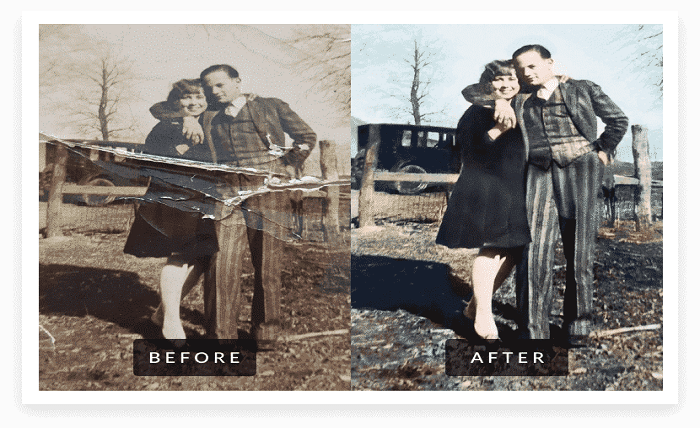In the era of digital transformation, the art of restoring photos allows us to bring damaged or aged photographic memories back to life, preserving our past in clearer detail. Photo restoration involves delicate processes that can breathe new life into faded, torn, stained, or otherwise damaged pictures, making them look as good as new. This guide serves as your comprehensive toolkit to understanding photo restoration, providing insights into why it’s important and how it’s done, thereby ensuring that your cherished moments are preserved forever.
The History of Photo Restoration
Photo restoration, as a practice, traces its roots back to the early days of photography. Initially, it was a meticulous manual process performed by skilled artists who would painstakingly retouch photographs by hand, using a variety of tools and materials to restore damaged or decayed works.
However, the advent of digital technology has revolutionized photo restoration. Modern techniques primarily use advanced software, allowing for a higher degree of precision and more complex restorations.
In contrast to manual retouching, digital restoration can address a wider range of issues such as severe discoloration, missing parts, or extensive water damage, while retaining the original photographic elements.
The Process of Photo Restoration
The process of photo restoration starts with the digitization of the original photo, if it isn’t already in a digital format. The photo is scanned at a high resolution to capture as much detail as possible.
Next, using advanced software like Adobe Photoshop, the restorer meticulously goes through the image, pixel by pixel, repairing any damages such as scratches, stains, tears, or faded colors.
This involves techniques like spot healing, clone stamping, color correction, and many more. The level of restoration depends on the condition of the original photo and the desired outcome.
Once the restoration work is completed, the photo is printed on high-quality photo paper or can be stored digitally. This allows the revived image to be shared, printed, and cherished just like any other digital photo.
Tools and Techniques Used in Photo Restoration
1. Spot Healing Brush Tool
The Spot Healing Brush Tool in Adobe Photoshop is a commonly used feature in photo restoration. This tool works by taking a sample from an area of the photo that you choose, called the source, and using it to cover up an unwanted part of the photo, like a scratch or a stain. This technique is particularly effective when you need to repair small spots or blemishes.
2. Clone Stamp Tool
The Clone Stamp Tool is another notable feature used in photo restoration. It works similarly to the Spot Healing Brush, but you have more control over the source location. This tool is beneficial when you need to duplicate or remove larger details or patterns in a photo.
3. Color Correction
Color Correction is a crucial aspect of restoring faded or discolored photos. Tools like Curves, Levels, and Hue/Saturation in Photoshop allow you to adjust the colors in your image to make them appear more natural and vibrant. This process can be complicated as it often involves correcting each color channel individually.
4. Patch Tool
The Patch Tool is ideal for fixing larger areas of a photo. You can use it to draw around a damaged area and then drag that area to a clean spot. Photoshop will then blend the clean spot into the damaged area, which can be extremely effective for restoring larger areas of damage or discoloration.
5. Noise Reduction
Noise Reduction tools are used to smooth out ‘grainy’ or ‘noisy’ images. This is especially useful for older photos that have a high amount of grain or noise, or for photos that have been digitized at a high resolution. Tools like the Reduce Noise filter in Photoshop can help to create a cleaner, clearer final image.
How to Choose a Photo Restoration Service
When deciding on a photo restoration service, several important factors should be considered. First and foremost, examine the quality of their work by requesting for samples or exploring their portfolio. This gives you an idea of the results you can expect. Secondly, consider their expertise and experience in restoring photos. Companies like MemoryCherish have a proven track record in this field and are adept at handling a wide range of photo damages. Third, read reviews and testimonials from previous customers to gauge the company’s reliability. Lastly, consider their pricing structure and turnaround time. It’s important to find a service that not only fits your budget but also delivers the restored photos in a timely manner.
Ultimately, photo restoration is an art that requires a combination of skill and creativity. By following the tips outlined in this guide, you’ll be well on your way to finding the best service for preserving your memories in perfect condition!
What are the Benefits of Photo Restoration?
Preserving our memories by restoring old photos provides us with many benefits. Firstly, it allows us to preserve the original image and colors of a photo as much as possible. For example, manual restoration techniques used by experts can help to bring back details that are impossible to obtain from digital retouching alone. Secondly, restored photos look much better than their damaged or faded counterparts. The resulting images have brighter colors and sharper detail which make them look more vibrant and professional. Finally, restoring photos allows us to bring back memories from the past that would otherwise be lost forever.
The process of photo restoration can seem intimidating at first, however it is an invaluable tool for preserving our treasured memories in perfect condition. With the right service and knowledge, you can ensure that your cherished moments are preserved forever.
Conclusion
Photo restoration is an important part of preserving our memories for generations to come. With modern tools and techniques, it’s possible to restore even the most damaged images back to their original or near-original condition. Additionally, photo restoration services such as MemoryCherish have made the process simpler and more efficient than ever before.
In the end, photo restoration is an invaluable tool for preserving our memories and protecting them from fading away with time. So why not give your old photos a new lease of life? Restore them today and experience the joy of rediscovering a forgotten moment in perfect condition!



